
FEATURE — The horse has impacted our history more than any other animal. History recalls their use to transport us across continents, to deliver our mail, plow fields that feed us and herd cattle. Millions of burros and mustangs – free-roaming horses – were commissioned to be comrades and soldiers in the Civil War, Spanish-American War and World War I.
Today the horse is not only an icon for history and freedom but an entertainer, athlete and friend. More than 6 million horses are in the care of American horse lovers today. Mankind and horses have always had a special relationship. The animal is admired for its grace, intelligence, strength and speed, and while mustangs are a point of controversy in the West, they also possess an undeniable mystique for many.
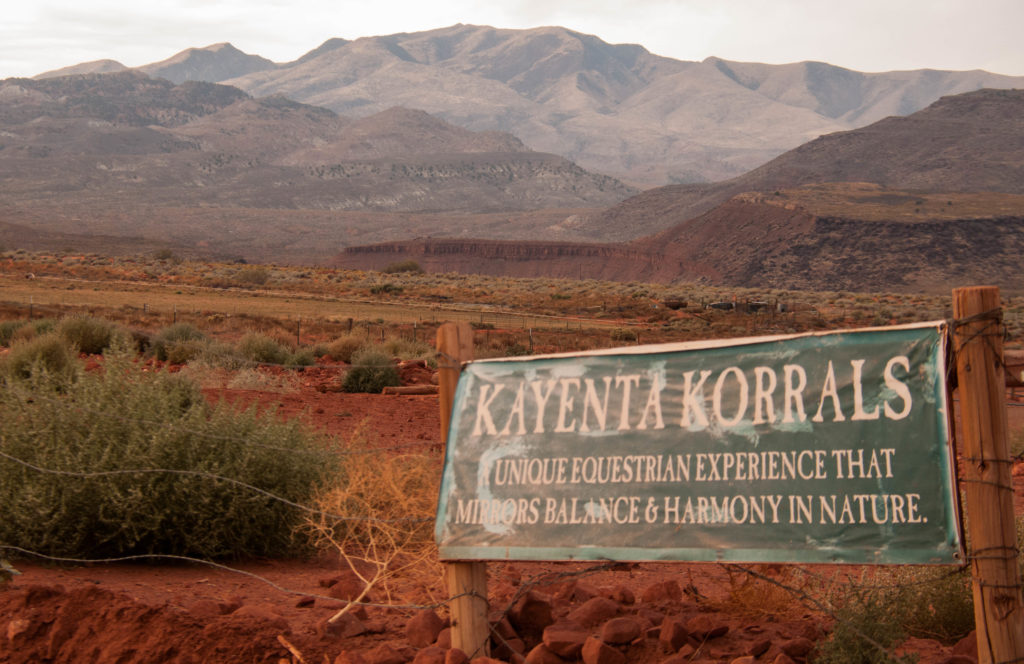
Kayenta Korrals in Ivins is home to a herd of 30 mustangs adopted through a Bureau of Land Management program. Marcia Thayne, program director of the not-for-profit organization Windhorse Relations Inc., said the corrals not only provide the wild horses a safe place to live but offer visitors a unique equestrian experience “where heart meets horse.”
In a two-hour adventure, participants come to understand the wild horse’s perspective. When horses learn to trust, they will accept humans as their leader. A critical component of this training is to create a safe space for the horse and participant. During this process, Thayne said, the horse is never restrained and always has the freedom to flee if uncomfortable.
A horse communicates by giving signals with its posture, tail and head movements. “Nothing mysterious,” Thayne said.
Participants learn to observe the horse’s nonverbal language, such as ear positions. Ears that are straight forward mean the horse is attentive. Ears pinned back mean it’s angry. Ears that are flicking back and forth are a sign that the horse is anxious or may be trying to locate a frightening sound or smell.
One participant in the “M.E.E.T.” program, which stands for Mustang Educational Experiential Teachings, grew up in Texas. She said there is nothing “speedy” about gentling a horse … “except learning patience.”
This was the woman’s second time participating in the program. She attended the session because she said she needed a good “horse fix.” Her husband came along because he wanted to do the “Western thing.”
Mustangs; past, present and future
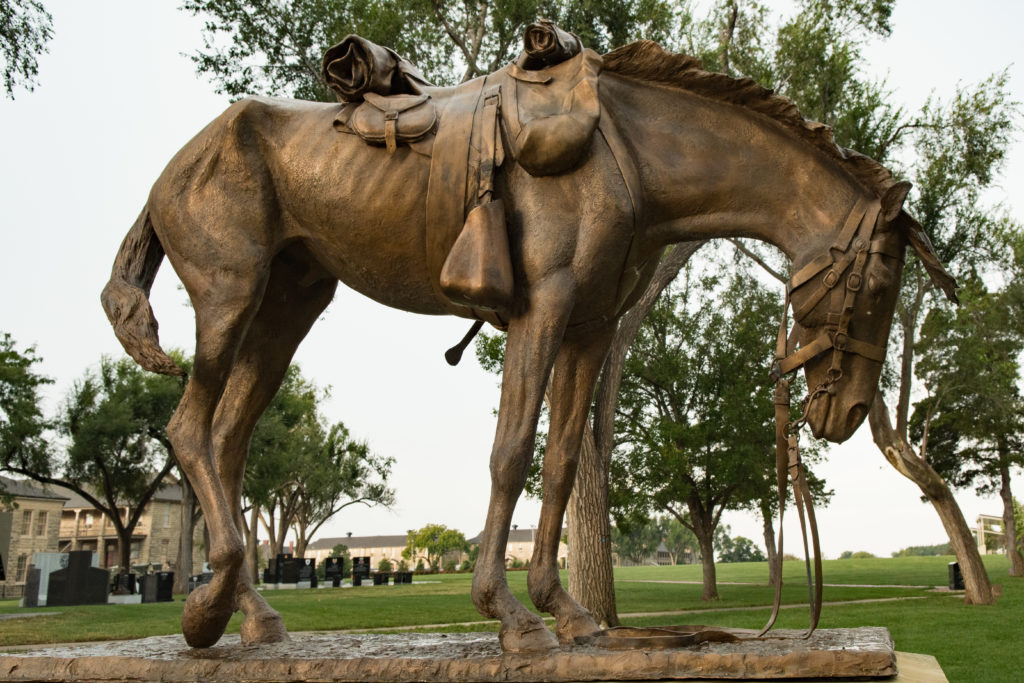
Mustangs were originally transported to America by Spanish conquistadors at the time of Columbus, Thayne said. Over the years mustangs crossbred with various domestic breeds. Some have bloodlines from perhaps discarded draft horses that wandered into the wilds, she said. A varied history of mining, ranching and homesteading has influenced each herd.
Mustangs vary in color, size and stature, and herds have a clear social hierarchy even at Kayenta Korrals.
“Hickory thinks he’s a movie star,” Thayne said of one of the horses. “He is a handsome dun with a dorsal stripe down his back. He knows he’s a fine-looking fellow.”
In the wild, a mare usually leads a band. Onyx is a big black mare who dominates at Kayenta Korrals.
Another mare named Pearl came to them at the beginning of the year.
“We noticed she was not losing her baby fat,” volunteer Martha Gorton said, “and by April out came Aspen, the first filly born here.”
A stallion typically watches over the mares and foals, keeping other stallions away. When young male horses reach the age of 2 or 3 years, they are kicked out and form bachelor bands.
“We call them Velcro boys,” Gorton said. Various bands become a herd and stay in the same general area on the range.

In the wild, mustangs have adapted as strong, fast and sure-footed and can live up to 40 years. They eat wild food such as tumbleweed – which prevents colic – as well as sage, thistles and all types of grasses, which they prefer. Their hooves are straight and tough and don’t require shoes.
In captivity, a dentist has to file a horse’s teeth. In the wild, they chew on rocks to take sharp points away.
The mustang is not on any endangered list at this time. This is largely in part thanks to Velma “Wild Horse Annie” Brown Johnson, an animal rights activist who urged the government to take action in the 1950s.
Johnson became aware of the ruthless way in which wild horses were gathered from grasslands and subsequently treated when she spotted a truck transporting mustangs on her way to work one morning.
Alarmed by a stream of blood dripping from the truck, she followed it all the way to a rendering plant. Hiding behind some bushes, she watched as the frightened horses were unloaded. A young foal had been trampled.
In 1959, the “Wild Horse Annie Act,” sponsored by Rep. Walter Baring, D-Nevada, was passed by Congress. But the bill did not include Johnson’s recommendation to protect, manage and control wild horses and burros.
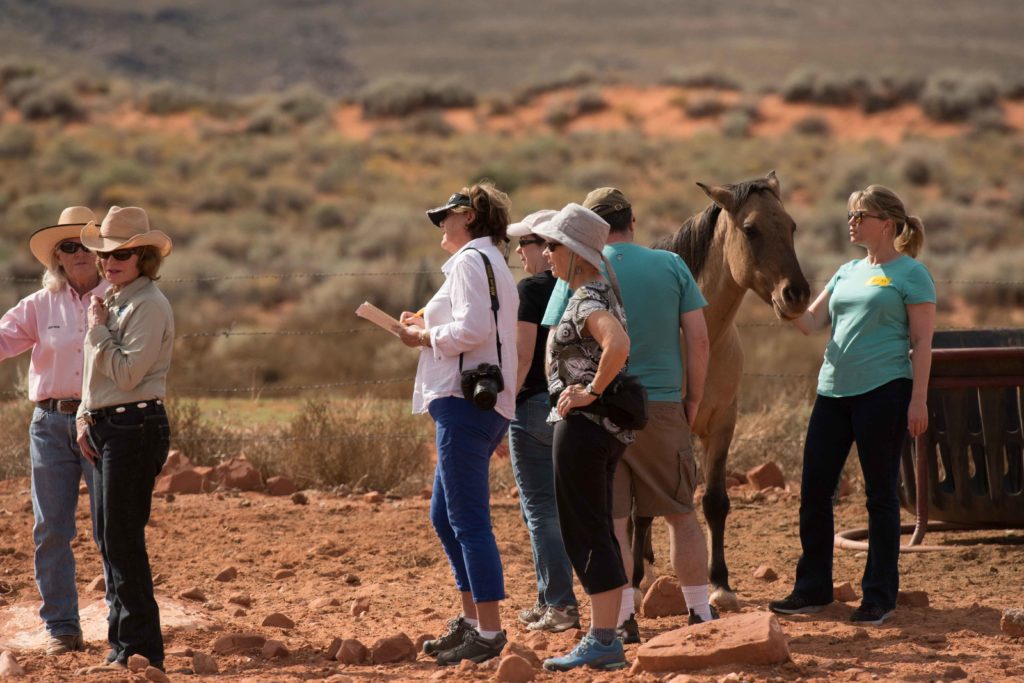
Johnson continued to get public support, and the Wild and Free-Roaming Horses and Burros Act of 1971 gave the Bureau of Land Management the responsibility to protect, manage and control the range and animals. The bill declared horses and burros to be “living symbols of the historic and pioneer spirit of the West” giving these gallant mustangs a right to survive.
Read more about “Wild Horse Annie” here.
Chad Hunter, Southern Utah’s range and wild horse specialist at the BLM, explained the controversy that has surrounded the ranching industry and free-ranging mustangs in the past as well as the present. In Utah there are 23 wild horse herds and 2,100 mustangs in holding pens waiting to be adopted or sold, he said.
“It’s all about sharing land and resources – grass and water,” Hunter said. “An estimated 70,000 mustangs still roam freely on the plains of America today. That number is over the ability for the range to support.”
The topic of the mustang is always on the minds of ranchers. Because the free-roaming horses eat vegetation to the ground, the grass does not grow back. And water in the desert is a premium. Wild horses can smell water 2 miles away and love to hang out by the water holes and ponds, grazing away the feed. Most ranchers mitigate the problem of overgrazing of their cattle with fenced pastures. However, mustangs can easily jump a fence.
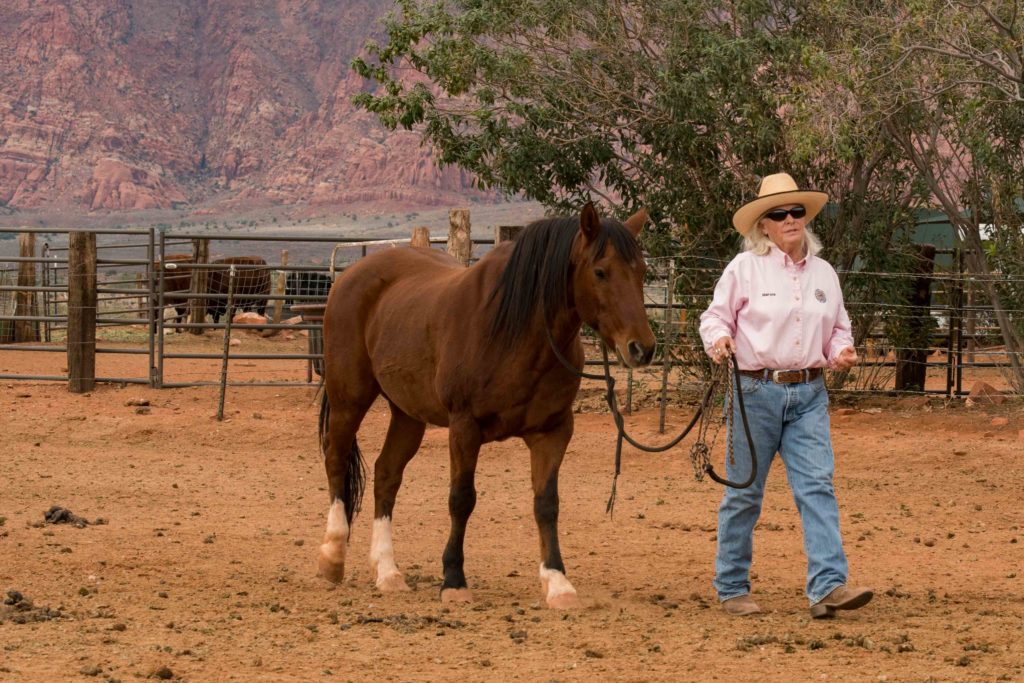
A portion of the wild herds has been removed to holding pens in anticipation of preserving enough food for animals still on the range. The BLM spends millions of taxpayers’ dollars on feeding, freeze branding, and caring for the captive herds every year, Hunter said.
Some of the captive horses are being tamed and trained by prisoners at various state penitentiary facilities. They “green break” the mustangs, working with them for 100 days. This allows the horse to be saddled, follow the trainer, stop and trot on command.
“This is an excellent example of animals helping people and people helping animals,” Thayne said.
Intimidation doesn’t work, she said. If these men are going to be successful horse trainers, they must transform. They have to gentle the horses and earn their trust.
Auctions are then held through BLM’s “Wild Horse & Burro Internet Adoption Program,” which has helped more than 200,000 horses and burros to be taken off the range since 1976.
Additionally, Hunter said, a source of birth control is being tested on the herds in the wild. Sensitive sharp shooters are required to hit a mare’s rump at distances of up to 60 yards. Field darters use a prepared shot of porcine zona pellucida – or PZP – once a year. Field darters must be subtle about shooting a mare in the precise place; the horse needs to think it’s been stung by a fly and not administered a shot by a human.

The next BLM internet adoption event will begin Jan. 31, 2017. To participate, a $125 deposit per animal – or $250 for a mare-foal pair – will be required to receive a bidder ID number.
However, there are also various facilities listed on the website with their own adoption specifications, including how to adopt the animals in person. The BLM has photos and bios of the adoptable mustangs. For more information, visit the BLM adoption website.
The BLM also has additional information, including maps and tips for viewing mustangs in the wild, a kids activity book and more, on their National Wild Horse and Burro webpage.
In addition, “Extreme Mustang Makeover” events sponsored by The Mustang Heritage Foundation are held across the United States in an effort to increase the adoption rates of mustangs being held by the BLM. Trainers compete for cash and prizes while displaying the trainability, versatility and beauty of the rugged American mustangs.
Visiting Kayenta Korrals
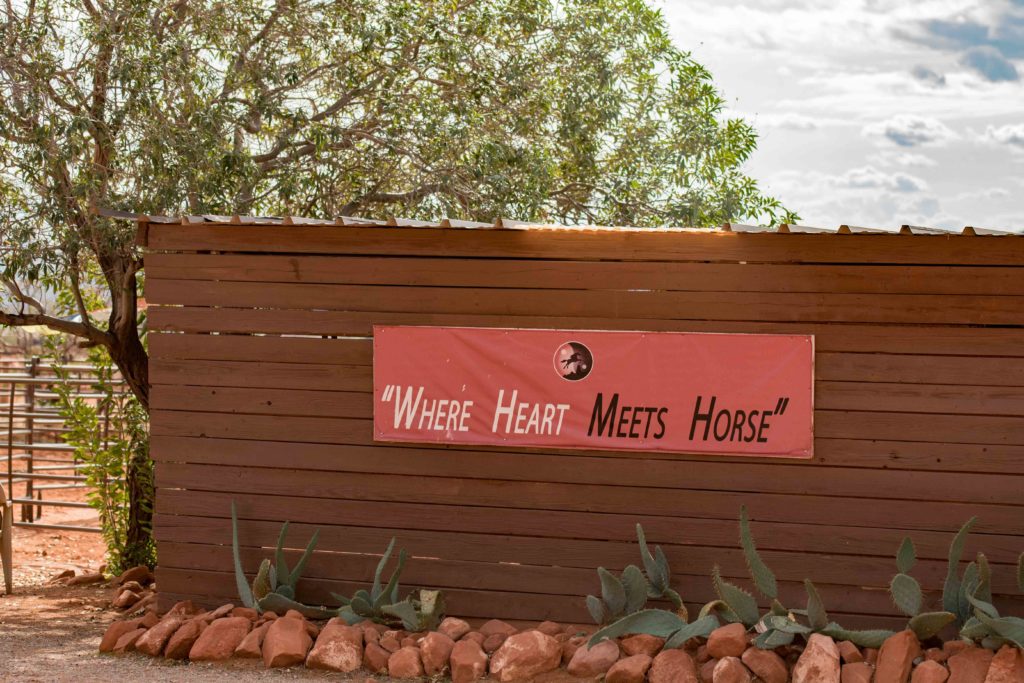
Kayenta Korrals is located 10 miles west of St. George in Ivins, Utah. The address is 650 W. 450 N; at the intersection turn west onto a dirt road. The mustangs can be viewed grazing in the fields.
If you are interested in a M.E.E.T. session, you must make a reservation by calling Marcia Thayne at 801-557-1257. This unforgettable experience and adventure is taught on all Mondays, Wednesdays and Saturdays from 1:30-3:30 p.m. The cost is a $100 donation to benefit the Windhorse herd.
For more information, go to the Windhorse Relations website.
Ed. note: Analysis of the diverse views on wild horse and burro issues in Utah is beyond the scope of this feature series article.
Click on photo to enlarge it, then use your left-right arrow keys to cycle through the gallery.
L-R: Directors Marcia Thayne and Martha Corton and participants in M.E.E.T. the Mustangs, Kayenta Korrals, Ivins, Utah, Oct. 29, 2016 | Photo by and courtesy of Jim Lillywhite, St. George News "Hickory," one of the mustangs at Kayenta Korrals, Ivins, Utah, Oct. 29, 2016 | Photo by and courtesy of Jim Lillywhite, St. George News Kayenta Korrals, Ivins, Utah, Oct. 29, 2016 | Photo by and courtesy of Jim Lillywhite, St. George News Marcia Thayne leads a mustang at Kayenta Korrals, Ivins, Utah, Oct. 29, 2016 | Photo by and courtesy of Jim Lillywhite, St. George News Civil War Horse statue dedicated to horses and mules that perished or were used in the Civil War, Ft. Riley, Kansas, Oct. 29, 2016 | Photo by and courtesy of Jim Lillywhite, St. George News Kayenta Korrals, Ivins, Utah, Oct. 29, 2016 | Photo by and courtesy of Jim Lillywhite, St. George News Mustang watches Marcia Thayne's body language, Kayenta Korrals, Ivins, Utah, Oct. 29, 2016 | Photo by and courtesy of Jim Lillywhite, St. George News Kayenta Korrals, Ivins, Utah, Oct. 29, 2016 | Photo by and courtesy of Jim Lillywhite, St. George News Kayenta Korrals, Ivins, Utah, Oct. 29, 2016 | Photo by and courtesy of Jim Lillywhite, St. George News Kayenta Korrals, Ivins, Utah, Oct. 29, 2016 | Photo by and courtesy of Jim Lillywhite, St. George News Participant and mustang in training, Kayenta Korrals, Ivins, Utah, Oct. 29, 2016 | Photo by and courtesy of Jim Lillywhite, St. George News Participant and mustang in training, Kayenta Korrals, Ivins, Utah, Oct. 29, 2016 | Photo by and courtesy of Jim Lillywhite, St. George News











About the series “Days”
“Days” is a series with St. George News contributor, feature writer and photographer Kathleen Lillywhite. She said:
I write my stories for people who say, ‘What is there to do around St. George?’ and for new folks just moving into this area.
Read more: See all of the features in the “Days” series.
Email: [email protected] | [email protected]
Twitter: @STGnews
Copyright St. George News, SaintGeorgeUtah.com LLC, 2016, all rights reserved.



Excellent article! Very well written! Lots of information and background on the history of America’s wild horses. Photos are superb!
This is absolutely a fantastic article and very touching we are so blessed to be living in such a wonderful and exciting and loving community
Now you have made me love horses even more and want to visit this place. Nice work,